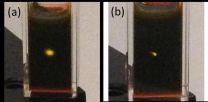(Press-News.org) DURHAM, N.C. -- The light-sensing molecules that tell plants whether to germinate, when to flower and which direction to grow were inherited millions of years ago from ancient algae, finds a new study from Duke University.
The findings are some of the strongest evidence yet refuting the prevailing idea that the ancestors of early plants got the red light sensors that helped them move from water to land by engulfing light-sensing bacteria, the researchers say.
The results appear online in Nature Communications.
"Much like we see the world through our eyes, plants 'see' the world through light-sensitive proteins in their leaves called photoreceptors," said Duke postdoctoral researcher Fay-Wei Li.
Photoreceptors monitor changes in the direction, intensity, duration and wavelength of light shining on a plant, and send signals that tell plants when to sprout, when to blossom, and how to bend or stretch to avoid being shaded by their neighbors.
"Light is what gives plants the energy they need to survive," Li said. "But light is constantly changing with the time of day and the seasons and the surrounding vegetation. Photoreceptors help plants determine if it's summer or winter, or if they're under the canopy or out in the open."
A group of photoreceptor proteins called phytochromes enable plants to detect and absorb light in the red and far-red regions of the light spectrum, the main wavelengths of light that plants use for photosynthesis.
Just 20 years ago, researchers discovered that plants weren't the only living things with phytochromes. Thanks to DNA sequencing, scientists started uncovering similar genes in cyanobacteria, tiny green bacteria that live in oceans, rivers and streams.
Based on the striking similarities between the phytochrome genes in plants and cyanobacteria, scientists proposed that plants acquired their phytochromes millions of years ago by engulfing cyanobacteria that were living independently.
Instead of digesting them, the theory goes, the plant ancestors supplied a safe home for the cyanobacteria to grow, and the cyanobacteria supplied their light-harvesting machinery to help capture energy from the sun, until the two grew dependent upon one another and eventually joined together to become permanent partners.
The idea is a widely accepted explanation for the origin of chloroplasts, the organelles in plant cells that convert sunlight to food.
But in more recent years researchers have also discovered phytochrome genes in bacteria, fungi and some algae, which got them thinking again: "Where did plant phytochromes come from?" Li said.
To find out, Li and Kathleen Pryer of Duke and Sarah Matthews of Harvard scoured existing databases and analyzed 300 DNA and RNA sequences from the phytochrome proteins of a wide range of algae and land plants, including ferns, mosses, liverworts, hornworts, green algae, red algae, kelp, diatoms and other green blobs commonly found in ocean plankton.
By calculating the similarities between the sequences, the researchers were able to reconstruct the genetic changes that these red light sensors underwent as they were passed from one lineage to the next.
Plant phytochromes turned out to be more closely related to algae than cyanobacteria, consistent with suspicions that earlier ideas about their bacterial origins may not be right after all.
The researchers also found a surprisingly diverse array of phytochromes in green algae, which could help scientists better understand how plants transitioned from life in the water to life on land.
Plants are generally thought to have colonized land more than 400 million years ago, when pioneering green algae -- perhaps living at the edges of freshwater pools -- managed to survive when water levels dropped on shore.
The previously unknown diversity of phytochromes in green algae suggests that the aquatic and semi-aquatic ancestors of early plants could absorb and use wavelengths of light that modern land plants can't "see."
"The first ancestral algae to move onto land would have faced a very different light environment than they experienced in the water -- a lot more light, and in different wavelengths," Li said. "Photoreceptors played a key role in helping plants adapt to these changing light conditions."
INFORMATION:
Other authors include Michael Melkonian of the University of Cologne, Carl Rothfels of University of California, Berkeley, Juan Carlos Villarreal of the Royal Botanic Gardens in Scotland, Dennis Stevenson of the New York Botanical Garden, Sean Graham of the University of British Columbia and Gane Ka-Shu Wong of University of Alberta and BGI-Shenzhen.
This research was supported by the National Science Foundation (DEB-1407158).
CITATION: "Phytochrome Diversity in Green Plants and the Origin of Canonical Plant Phytochromes," Li, F. et al. Nature Communications, July 28, 2015. DOI: 10.1038/ncomms8852
OAK BROOK, Ill. - Specific cardiovascular risk factors, such as alcohol consumption, smoking, obesity and diabetes, are associated with smaller regional brain volumes that may be early indicators of Alzheimer's disease and dementia according to a study published online in the journal Radiology.
"We already know that vascular risk factors damage the brain and can result in cognitive impairment," said Kevin S. King, M.D., assistant professor of radiology at the Keck School of Medicine of the University of Southern California in Los Angeles. "But our findings give us a more ...
Adding omega-3 fatty acids to anti-tumor medications may improve treatment response and quality of life for cancer patients according to a new study by researchers at the University Hospitals of Leicester in the United Kingdom.
The study, published today in the OnlineFirst version of the Journal of Parenteral and Enteral Nutrition (JPEN), the research journal of the American Society for Parenteral and Enteral Nutrition (A.S.P.E.N.), examined 50 patients with advanced pancreatic cancer.
Patients were given 1,000 mg of gemcitabine weekly followed by up to 100 g of omega-3 ...
A new study finds that exogenous glucagon-like peptide 2 (GLP-2) treatment may help fight neonatal parenteral nutrition-associated liver disease (PNALD).
The study, published today in the OnlineFirst version of the Journal of Parenteral and Enteral Nutrition (JPEN), the research journal of the American Society for Parenteral and Enteral Nutrition (A.S.P.E.N.), provided neonatal piglets with 17 days of parenteral nutrition therapy and either GLP-2 treatment or saline control. In a previous study, the researchers found that GLP-2 therapy improved bile flow and serum markers ...
Babies born very premature or severely underweight are at heightened risk of becoming introverted, neurotic, and risk averse as adults, indicates research published online in the Archives of Disease in Childhood (Fetal & Neonatal Edition).
This personality profile may help to explain the higher rates of career and relationship difficulties experienced by this group as adults, suggest the researchers.
Very premature birth at less than 32 weeks and/or very low birthweight of less than 1500 g are known to be linked to a heightened risk of autistic spectrum behaviours, ...
Depression and personality disorders are the most common diagnoses among Belgian psychiatric patients requesting help to die, on the grounds of unbearable suffering, finds research published in the online journal BMJ Open.
Drugs, given either by mouth or administered intravenously, are used to perform euthanasia in Belgium, where the practice has been legal since 2002.
The researchers wanted to find out if there were any discernible patterns in requests for euthanasia among mentally ill patients in Belgium in a bid to inform recommendations for future research.
So ...
1. Placebo delivery method affects patient response to "therapy"
Free abstract: http://www.annals.org/article.aspx?doi=10.7326/M15-0623
URLs go live when embargo lifts
A systematic evidence review published in Annals of Internal Medicine finds that the way in which a placebo is delivered makes a difference in how patients respond to "therapy." Having a clinically significant response to the sham treatment could substantially affect outcomes in placebo-controlled trials. The data suggests that some placebos have a stronger effect than others.
Placebo controls, ...
The University of Colorado Cancer Center and Loxo Oncology, Inc. (Nasdaq:LOXO), a biopharmaceutical company focused on the discovery, development and commercialization of targeted cancer therapies, today announced the publication of a research brief in the online edition of the journal Cancer Discovery, describing the first patient with a tropomyosin receptor kinase (TRK) fusion cancer enrolled in the Phase 1 dose escalation trial of LOXO-101, the only selective TRK inhibitor in clinical development. Additional contributors to the paper include the Knight Cancer Institute ...
RIVERSIDE, Calif. -- When it comes to installing solar cells, labor cost and the cost of the land to house them constitute the bulk of the expense. The solar cells -- made often of silicon or cadmium telluride -- rarely cost more than 20 percent of the total cost. Solar energy could be made cheaper if less land had to be purchased to accommodate solar panels, best achieved if each solar cell could be coaxed to generate more power.
A huge gain in this direction has now been made by a team of chemists at the University of California, Riverside that has found an ingenious ...
A Johns Hopkins-led study of outcomes among 1,200 people with implanted defibrillators -- devices intended to prevent sudden cardiac death from abnormal heart rhythms -- shows that within a few years of implantation, one in four experienced improvements in heart function substantial enough to put them over the clinical threshold that qualified them to get a defibrillator in the first place.
A report on the study, published in the Aug. 4 issue of the Journal of the American College of Cardiology, reveals these patients had markedly lower risk of dying and were far less ...
In a project spearheaded by investigators at UC San Francisco, scientists have devised a new strategy to precisely modify human T cells using the genome-editing system known as CRISPR/Cas9. Because these immune-system cells play important roles in a wide range of diseases, from diabetes to AIDS to cancer, the achievement provides a versatile new tool for research on T cell function, as well as a path toward CRISPR/Cas9-based therapies for many serious health problems.
Using their novel approach, the scientists were able to disable a protein on the T-cell surface called ...

